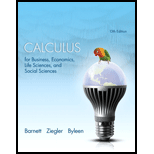
Concept explainers
B In Problems 15 and 16, explain which of (A), (B), and (C) are equal before evaluating the expressions. Then evaluate each expression to two decimal places.
15. (A)
(B)
(C)
Want to see the full answer?
Check out a sample textbook solution
Chapter 6 Solutions
Calculus for Business Economics Life Sciences and Social Sciences Plus NEW
- 2. Consider the following argument: (a) Seabiscuit is a thoroughbred. Seabiscuit is very fast. Every very fast racehorse can win the race. .. Therefore, some thoroughbred racehorse can win the race. Let us define the following predicates, whose domain is racehorses: T(x) x is a thoroughbred F(x) x is very fast R(x) x can win the race : Write the above argument in logical symbols using these predicates. (b) Prove the argument using the rules of inference. Do not make use of conditional proof. (c) Rewrite the proof using full sentences, avoiding logical symbols. It does not need to mention the names of rules of inference, but a fellow CSE 16 student should be able to understand the logical reasoning.arrow_forwardFind the inverse of the matrix, or determine that the inverse does not exist for: € (b) 7 -12 240 1 1 1 (c) 2 3 2 2 17 036 205 20 (d) -1 1 2 1 T NO 1 0 -1 00 1 0 02 (e) 1 0 00 0 0 1 1arrow_forward4. Prove the following. Use full sentences. Equations in the middle of sentences are fine, but do not use logical symbols. (a) (b) (n+3)2 is odd for every even integer n. It is not the case that whenever n is an integer such that 9 | n² then 9 | n.arrow_forward
- 3. (a) (b) Prove the following logical argument using the rules of inference. Do not make use of conditional proof. Vx(J(x)O(x)) 3x(J(x) A¬S(x)) . ·.³x(O(x) ^ ¬S(x)) Rewrite the proof using full sentences, avoiding logical symbols. It does not need to mention the names of rules of inference, but a fellow CSE 16 student should be able to understand the logical reasoning.arrow_forward3. Pleasearrow_forwardWhat does the margin of error include? When a margin of error is reported for a survey, it includes a. random sampling error and other practical difficulties like undercoverage and non-response b. random sampling error, but not other practical difficulties like undercoverage and nonresponse c. practical difficulties like undercoverage and nonresponse, but not random smapling error d. none of the above is corretarrow_forward
- solve on paperarrow_forwardsolve the question based on hw 1, 1.41arrow_forwardالتمرين الأول: 08) نقاط) نرمي رباعي وجوه مرقم من ا إلى 4 بحيث إحتمال وجوهه يحقق العلاقة التالية: - 24 = (3)P(1) = ) = 4P -1 أحسب احتمال كل وجه. -2 (١ أحسب احتمال الحادثة : الحصول على عدد زوجي). ب استنتج احتمال الحادثة ة. -3 أحسب احتمال الحادثة B الحصول على عدد د أكبر أو يساوي (2)arrow_forward
- Algebra & Trigonometry with Analytic GeometryAlgebraISBN:9781133382119Author:SwokowskiPublisher:Cengage
 Mathematics For Machine TechnologyAdvanced MathISBN:9781337798310Author:Peterson, John.Publisher:Cengage Learning,
Mathematics For Machine TechnologyAdvanced MathISBN:9781337798310Author:Peterson, John.Publisher:Cengage Learning, Algebra: Structure And Method, Book 1AlgebraISBN:9780395977224Author:Richard G. Brown, Mary P. Dolciani, Robert H. Sorgenfrey, William L. ColePublisher:McDougal Littell
Algebra: Structure And Method, Book 1AlgebraISBN:9780395977224Author:Richard G. Brown, Mary P. Dolciani, Robert H. Sorgenfrey, William L. ColePublisher:McDougal Littell


